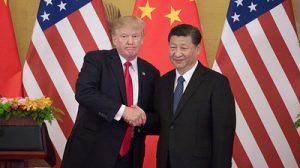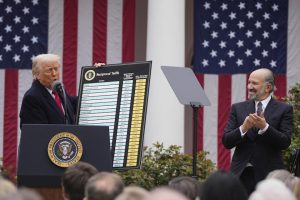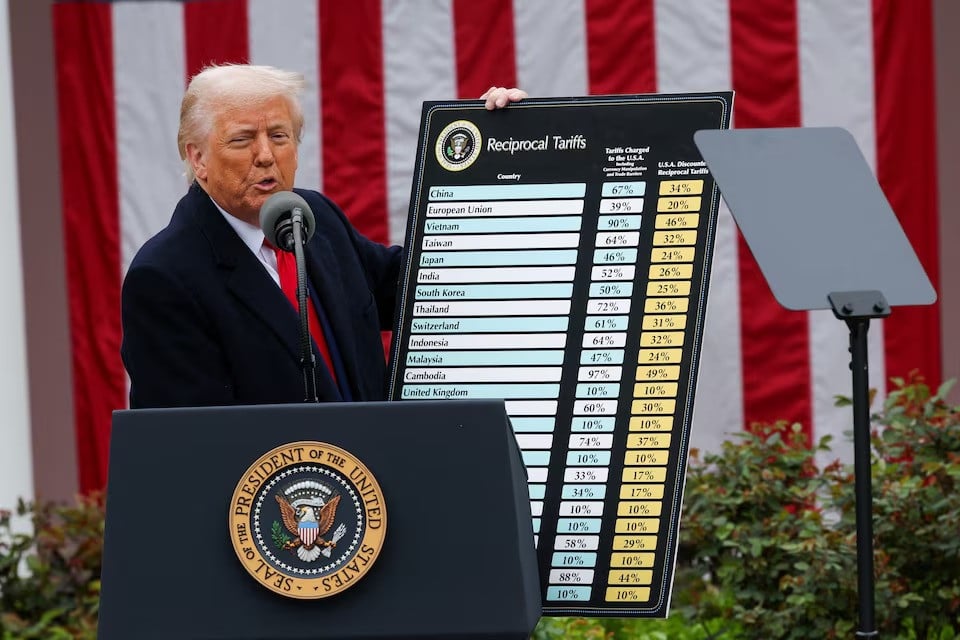In a dramatic reversal, US markets surged higher on Wednesday when US President Donald Trump announced he would temporarily reduce the heavy penalties he had recently levied on dozens of countries while increasing pressure on China.
In the most recent development, Trump announced that he would halt specific tariffs on other nations for three months in order to give US officials the opportunity to engage in negotiations with nations that have attempted to lower them.
However, he continued to put pressure on China, the US’s second-largest import supplier. A high-stakes conflict between the two biggest economies in the world intensified when Trump announced he will increase the tariff on Chinese goods from the 104% level that went into effect at midnight to 125%. Over the past week, the two nations have frequently exchanged tit-for-tat tariff increases.
Trump has not completely reversed the country-specific tariffs. The White House said that a blanket 10% levy on nearly all US imports will continue to be in place. Additionally, the move doesn’t seem to change existing tariffs on steel, aluminum, and automobiles.

Following the news, US market indexes surged higher, with the benchmark S&P 500 index finishing 9.5% higher. The dollar recovered against safe-haven currencies, while bond rates dropped from their previous highs.
Following the most severe bout of financial market volatility since the early days of the COVID-19 epidemic, Trump reversed course less than 24 hours after harsh new tariffs went into effect on the majority of trading partners. Trillions of dollars were wiped out from stock markets by the turmoil, and the unnerving spike in US government bond yields seemed to grab Trump’s attention.
After making his declaration, Trump told reporters, “I noticed last night that people were feeling a little nauseous.” “The bond market right now is beautiful.”
A days-long selloff triggered by Trump’s tariffs had depleted trillions of dollars from global stocks and put pressure on the dollar and US Treasury bonds, which are the foundation of the global financial system. Canada and Japan promised to intervene if necessary to bring stability, which is what the US typically does when there is an economic crisis.
The abrupt increase in share prices, according to analysts, might not completely repair the harm. According to a Reuters/Ipsos study, three out of four Americans anticipate price increases in the coming months, and surveys have shown a slowdown in family spending and company investment as a result of concerns about the effects of the tariffs.
Following Trump’s action, Goldman Sachs reduced its forecast of a recession from 65% to 45%, stating that the tariffs that remained in place would still probably cause the overall tariff rate to rise by 15%.

In response to inquiries about market turbulence, US Treasury Secretary Scott Bessent said the sudden reversal rewarded nations that had followed Trump’s instructions to avoid retaliation. He implied that Trump had created “maximum negotiating leverage for himself” by using the tariffs.
“This was his strategy all along,” Bessent said to reporters’ questions. One may even argue that he provoked China into a precarious situation. They answered. They have proven to the world that they are the evil actors.
Bessent serves as the point person for the country-by-country talks that could cover economic issues, military cooperation, and foreign aid. Trump has met with South Korean and Japanese leaders, and on Wednesday, a Vietnamese delegation was scheduled to meet with US officials.
Bessent will not comment on the length of time it might take to negotiate with the more than 75 countries that have contacted out. Trump claimed that a settlement with China was also feasible. However, officials have stated that they will give priority to discussions with other nations.
For the latest updates and insights on new developments, visit the NEWSON
Q1: What recent decision did President Trump make regarding tariffs?
President Trump announced a dramatic increase in tariffs on Chinese goods to 125%, up from 104%, while temporarily suspending certain tariffs on other countries for three months to allow time for negotiation.
Q2: Why did the US markets surge following the announcement?
Markets surged due to Trump’s reversal on broad tariffs, which reassured investors. The S&P 500 rose by 9.5%, the dollar strengthened, and bond yields dropped after days of financial turmoil.
Q3: Are all tariffs being lifted?
No. A blanket 10% tariff on nearly all US imports remains, along with existing tariffs on steel, aluminum, and automobiles.
Q4: What triggered Trump’s sudden policy shift?
The reversal came after a market meltdown erased trillions from global markets and caused surging bond yields, signaling deep investor concern. Trump acknowledged the pressure, stating: “The bond market right now is beautiful.”
Q5: How are other countries responding?
Countries like Canada and Japan expressed willingness to intervene for stability. Over 75 nations have reached out to the US for negotiations, with priority given to non-China partners.
Q6: What are the potential long-term impacts?
While markets recovered, analysts warn the damage may persist. A Reuters/Ipsos poll showed that 75% of Americans expect higher prices, and Goldman Sachs lowered its recession odds to 45%, citing the lingering effects of tariffs.


